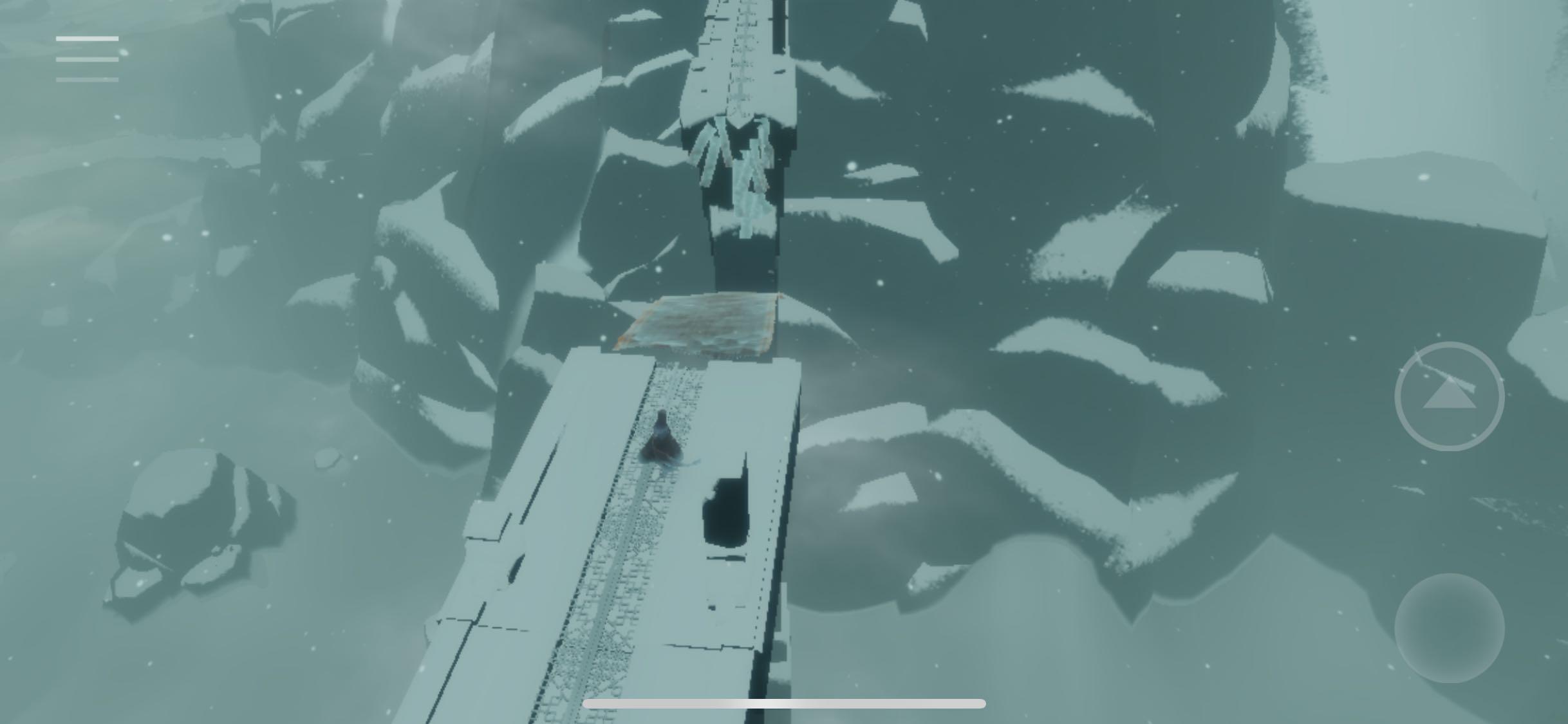Journey is a walking adventure game by Thatgamecompany and directed by Jenova Chen. It is available on Play Station, Windows system with Steam or Epic, and IOS. It targeted players of almost all ages (4+ on IOS) who would enjoy exploration of the desert world with fantastic visual components. I played Journey through IOS on my phone.
Journey tells the story through exploration with balanced infavoidance and challenges, as well as autonomy, isolation, and fellowship that motivates the players to continue till the end of the journey. Similar to other walking simulators, players walk in the world without fear of the death of the character, satisfying players’ psychological needs for infavoidance to enhance the aesthetic of exploration. Also, there is usually clear guidance of where to walk to at the end, such as the lights on the top of the mountain, or the red carpets that flies in front of you, so it is less likely for the players to get lost. For example, when I played the game, there were multiple times when I failed to walk to the next stage and fell to the lower ground. Such “failure” did not prevent me from being able to pass the stage, instead, I only needed to walk shortly to go back to the point where I fell and start again. Without any fear of death or losing my way, I explored more extensively to different places in the world.

I fell from the bridge three times but it did not take me long to walk back.
At the same time, Journey employs the difficulty curve with dynamics to prevent players from feeling bored. Each stage of the game involves different mechanisms to play, from simply walking, to sliding, flying with red carpets, hiding the huge dragon, to competing with the wind. Such differences encourage players to learn and the mechanism is straight-forward enough that it does not require much learning bias to enjoy the game. At the same time, the learning envokes thinking about strategies. For example, I was beaten down by the dragon twice in one stage, and in the final stage, I found that I was able to hide from the dragon with the architecture on the ground, so I strategically planned my route to walk around and was not beaten down by the dragon again. This also gave me the satisfaction from the power of defendance.

I learned that I would be beaten down by the dragon if discovered (left) and managed to hide from it with the building in the snow.
Finally, the game targets autonomy as motivation for playing and reflection enhanced by the balanced feeling of isolation and fellowship. Different from other exploration games, Journey does not have any narratives or texts, and everything, even the storytelling, depends on the players’ autonomy and imagination. When I was playing the game, I imagined the whole story and everything along the road. For example, where did the small monuments come from, and what do the red carpets that allow me to fly up to the mountain mean? Such questions keep me interested in going till the very end of the journey. Such thinking also invokes reflections on players’ own experiences, or journeys. In the game, I feel isolated from all other humans and have questions, such as, even though we met someone now, will we always be apart in the very end, and is companionship meaningful given that we always need to go to the end of the world alone? The feeling of isolation and fellowship enhances such reflection, especially when players are in the later stages, such as walking against the wind in the snow, where there is no one else in the world. The fellowship might also come from the other monuments on the road. For example, I wonder whether the monuments are representatives of other people going through the same journey, and I feel accompanied by red carpets when I interact and fly with them.

Even though I walked so long, I still “died” in the snow alone. Is it reflected in the reality that whatever we try, the final destiny is settled and fewer chances are here to overcome everything?
The game is also unique from others due to the striking and beautiful art that brings players ubiquitous sensual enjoyment. I really enjoyed the satisfaction of the sensation. Besides the beautiful scenes, it utilizes lots of contracts that make the players feel that they are small in such a large world, and the end of the story of falling down in the snow though being saved by other white robes gave me the feeling that it is not possible to survive the whole journey without any supernature’s help. Combined with the music, such feelings enhance players’ reflection and, for me, it is like a journey of meditation where I was immersed into the world to overcome the difficulties of my life.

It is striking when everything suddenly lighted up!
However, I think there are some flaws in the IOS platform where the small phone limits the sensation impression that the game can bring, given that the phone, or even iPad, is too small compared to the large screen from the laptop, monitor, or projector. At the same time, the control on my phone is too sensitive to my movements (though I used the lowest level of sensitivity) that it is hard to control directions to walk and fly, especially in the later of the game which requires accuracy in the movements. When I was playing, I really hoped to use a gamepad to control and project my phone to my monitor. Finally, there is auto-correction of the vision when players go to some places and the vision is limited. However, such auto-changing of the direction makes it harder to adjust where I can walk. I think it would be really helpful if the game could be more fine-tuned for the IOS platform. For example, it could be tested by more players to find the best sensitivities from players’ movements or introduce the mechanisms to connect to a gamepad or joystick. I also hope that Journey could enable cross-platform connections to other players. When I browsed the reviews on Steam, I found lots of players enjoy the fellowship they gain from encountering and walking with another player. However, I did not meet any other players and was eager to enjoy this companion. I think this might be because there are fewer players on IOS compared to Steam/Epic or PlayStation. If the cross-platform connections can be included, then more fun could be introduced by fellowship.

For unknown reasons, my vision was stuck in this direction multiple times, making it harder to keep walking.



